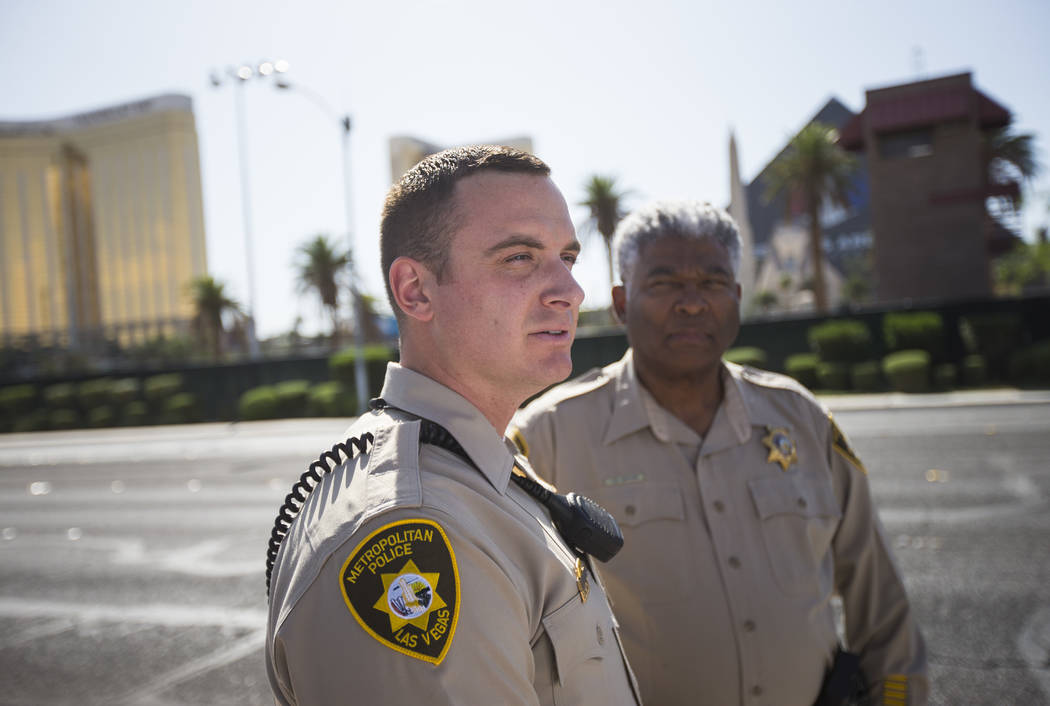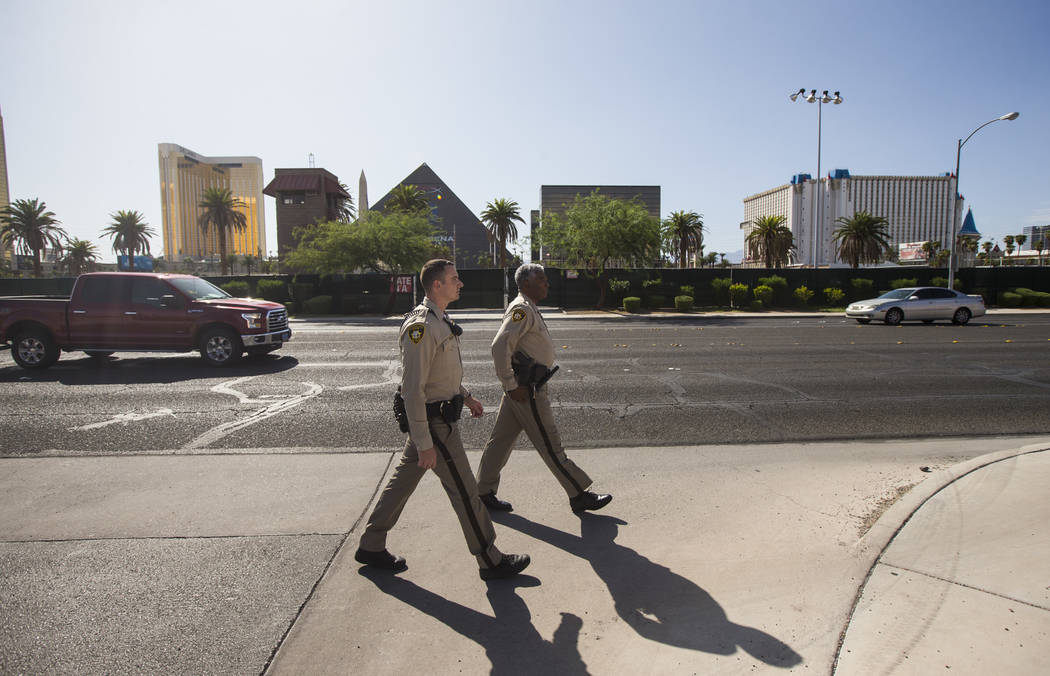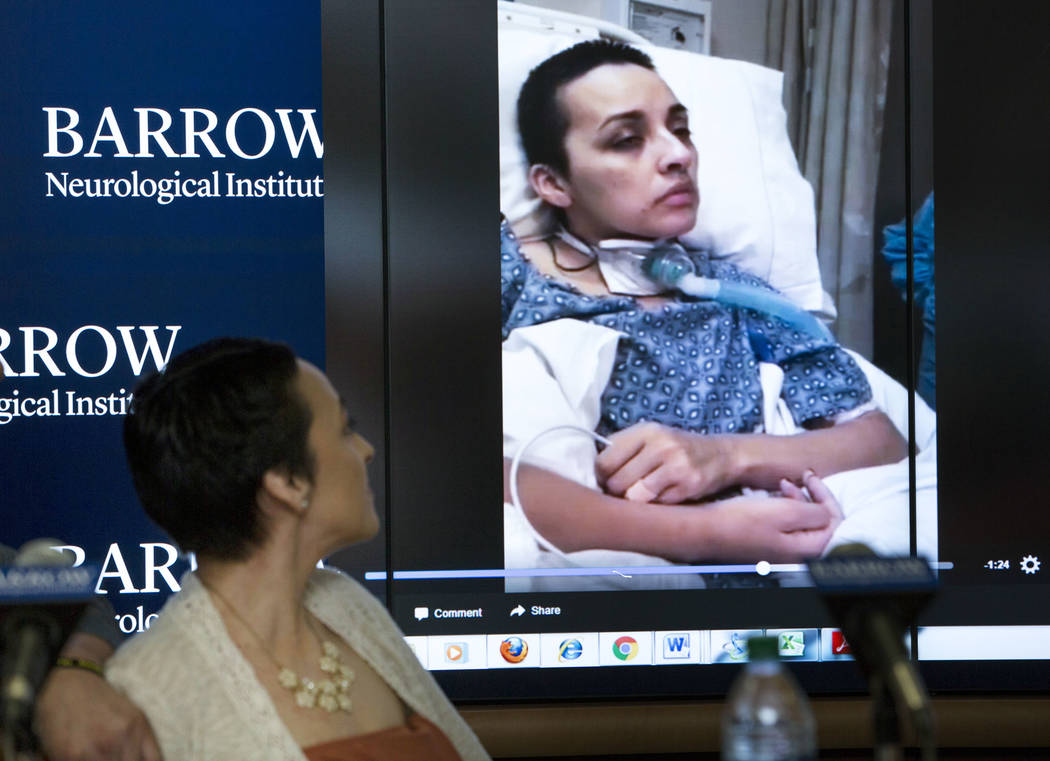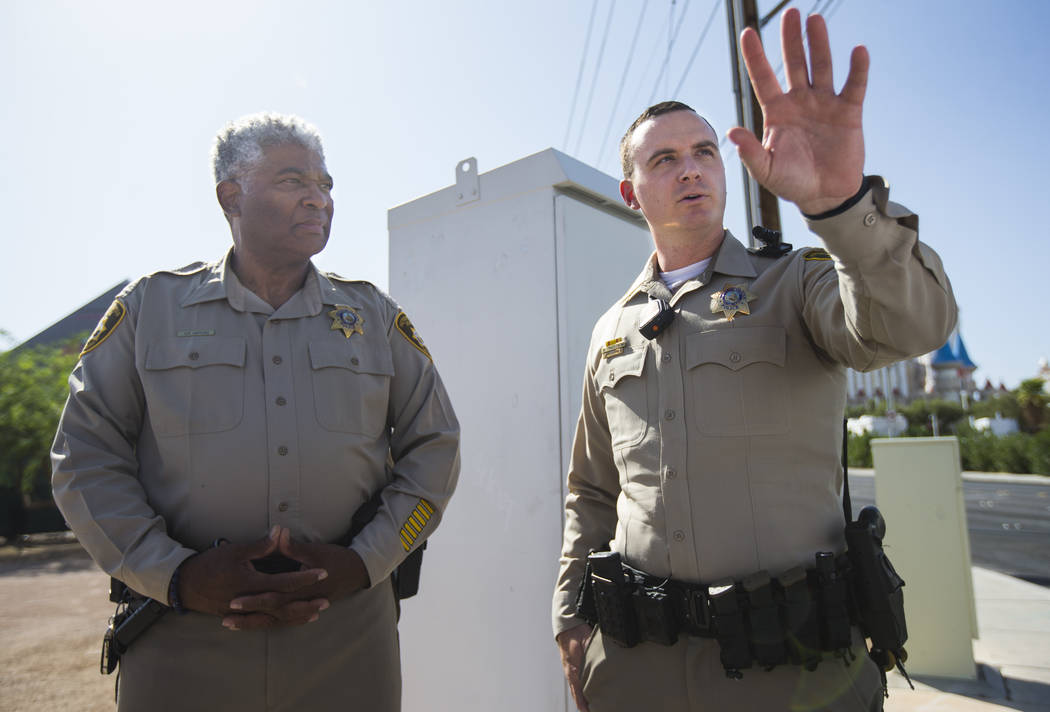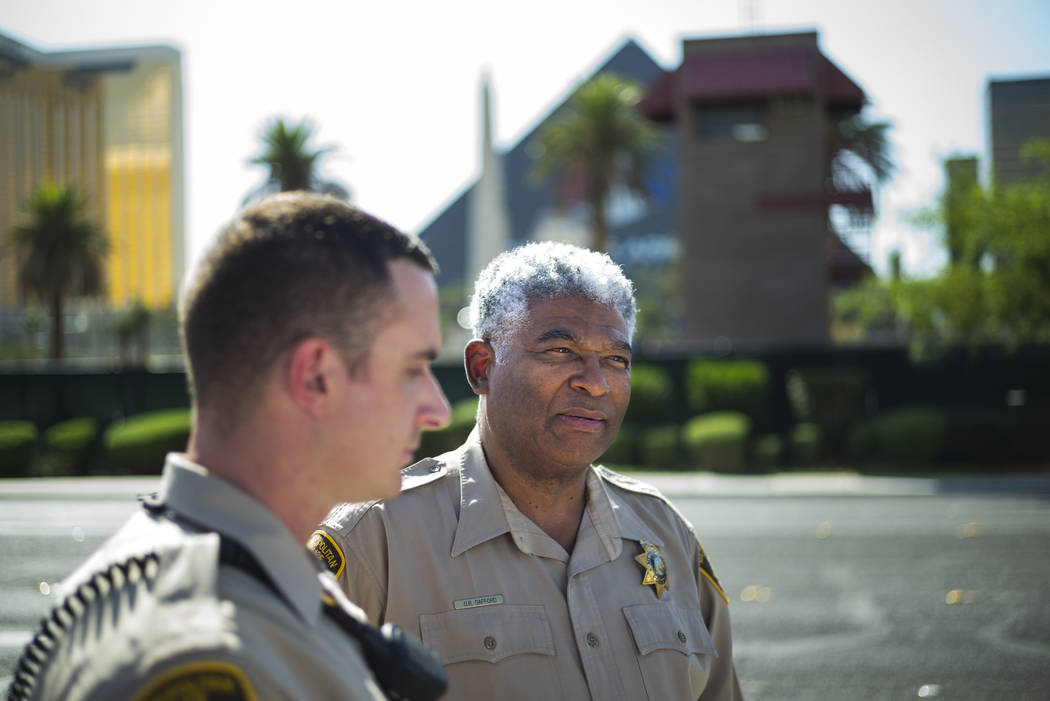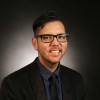In Las Vegas shooting chaos, Metro officers saved a life

This is part of an ongoing series observing the two-year anniversary of the Oct. 1, 2017, shooting at the Route 91 Harvest Festival. See all of our coverage here.
Las Vegas police officer Richard Cole’s hands firmly grip the wheel, his uniform blanketed in blood: “We’re almost there, man. Hang on!”
In the back of the Metropolitan Police Department SUV, Frank Calzadillas pleads with his wife, Jovanna, whose brain has been pierced by a bullet, to “breathe, baby!” He implores Cole, who is going over 100 mph on northbound Interstate 15, to drive even faster.
Rookie officer Brandon Engstrom, Cole’s field trainee, is in the passenger seat, about 20 minutes into a graveyard shift on his second day on the job. His mind races. What just happened? Is the threat over?
Traffic concedes to the flashing lights and wailing sirens, clearing the fast lane until the SUV peels off the freeway toward Charleston Boulevard in pursuit of University Medical Center.
In a flurry of radio dispatches — with automatic gunfire often ringing in the background — Metro officials provide evolving intelligence about a scene just east of the Las Vegas Strip: Multiple people have died, and at least one shooter appears to loom high in Mandalay Bay.
“It just really started to sink in,” Cole recalled during a recent interview, “that this is something that’s going to really hurt.”
It’s been two years since a gunman killed 58 people and injured hundreds more, raining bullets on Route 91 Harvest festivalgoers from his Mandalay Bay hotel suite. Over that time, stories of heroism and perseverance have risen from the depths of tragedy.
Through interviews and examination of police body camera footage, a clearer picture has emerged of one account: the intersection of two quick-thinking officers and a woman in dire straits.
“Of course I signed up to help people,” Engstrom said recently. “And then, you know, my second day going in, I got the chance.”
Listen to the Critical Condition podcast
Critical condition
When Cole, now 37, and Engstrom, now 30, meet Frank and Jovanna Calzadillas behind their police SUV, the two officers are confronting mass chaos.
At the cross section of East Reno Avenue and Giles Street on the night of Oct. 1, 2017, just northeast of the festival grounds, the officers take strategic cover behind a white utility box.
Thousands of panicked festivalgoers spill into the streets, including a man wearily bracing his arms around the shoulders of two friends, and another in a cowboy hat, crouching and perhaps shot, assuming refuge behind the officers’ vehicle. Many climb over the fence bordering the concert venue to escape imminent danger. Commingled yelling and intermittent bursts of gunfire can be heard as personal items, abandoned in the dash for safety, start to litter the gray asphalt.
“So I’m in a little bit of shock,” Engstrom said during a recent interview. “I’m trying to load our shotgun, and I’m just fumbling everywhere because I have no idea what’s going on.”
Officers direct people to keep moving, repeating instructions to those who seem dazed or bewildered. Cole and Engstrom have come from Metro’s Convention Center Area Command only a few miles away, where their shift started at 10 p.m. — five minutes before the first shots were reported.
Officers and other emergency responders from across the Las Vegas Valley have converged on the scene.
“It was probably the longest caravan of lights and sirens I’ve ever really been in other than police funerals,” Cole told the Las Vegas Review-Journal.
Then came Jovanna Calzadillas and her husband, an off-duty Arizona police officer who had announced himself as a cop and frantically begged Cole and Engstrom to save his wife.
“We knew it was beyond critical,” Engstrom said.
For Cole, the decision to leave with her was instant.
‘All hands on deck’
Jovanna Calzadillas was one of the first patients brought to UMC that night. Cole and Engstrom carried her into the emergency room, where Cole came across an employee who seemed unaware of what was happening.
“I told him, ‘It’s a terrorist attack. You need to get everybody in the hospital as quickly as you can,’ ” Cole said.
The hospital is located in the city’s Medical District, just west of downtown, and boasts one of the few standalone trauma centers in the U.S.
“When the call first came out, I don’t think anybody knew exactly how severe this was going to be,” said Dr. Paul Chestovich, UMC’s chief of trauma research.
Chestovich had just tucked his children into bed, ending a barbecue with family and friends, when he received several text messages about a potential mass shooting. He beelined to work. Meanwhile, Dr. Syed Saquib, medical director for the hospital’s Lions Burn Care Center, was on call in the hospital.
About 40 victims entered UMC within a half-hour of the shooting, most by private vehicle, according to the two trauma surgeons. More than 100 would arrive by the time their shift was over. The two personally treated many of them.
“That night, we went to the backup surgeon and then beyond,” Saquib said. “For something like this, it’s all hands on deck.”
Trouble on the mind
Normally when law enforcement officials escort shooting victims into a hospital, they stay with them, continue investigating and monitor their progress.
“But this was an unprecedented event where we knew there were hundreds of victims,” said Cole, who was nearly certain Jovanna Calzadillas was dead. “And we just needed to get back where we are needed most.”
Something new also was troubling Cole: His roommate, Anna Childs, was among the 22,000 people at the festival. In a rush to arrive at the shooting, he had left his cellphone in a bag at his substation. And he didn’t know her phone number by heart.
“Now I’m kind of going into panic mode. I had just seen somebody who had been shot in the head,” he said. “I’d seen a lot of people shot, and my train of thought is, you know, one of my best friends could be dead right now.”
The two officers were wanted in the parking lot at Metro’s South Central Area Command, near the iconic “Welcome to Fabulous Las Vegas” sign, where the smell of fresh gunpowder permeated the air. It is less than a mile south of Mandalay Bay. Most officers who did not respond directly to the festival went there to be assigned to strike teams, mapped out by marker on the hood and windshield of a patrol car.
Cole relayed what he knew about the scene, assisted with creating teams and responded to concerns from colleagues. The blood staining his uniform, he assured them, “it’s not mine.”
Comfort in chaos
Until his phone rang, George Gafford was relaxing at home, snacking on popcorn and watching the historical drama “Vikings,” a favorite television show. He joined Metro as a corrections officer in 1990 and had contemplated retirement. But when an opportunity arose to support officers and their families in 2015, he joined one of two teams on Metro’s Police Employee Assistance Program.
On that night, his team was on call. He wasn’t sure whether it was a false alarm until he heard a dispatcher say, “Bodies are down.”
Gafford scrambled room to room to find clothes. With his service vehicle in the shop, he jumped into a Clark County vehicle without emergency lights or sirens and charged behind an ambulance onto southbound I-15, which he said had been closed to civilians. He was told to go to the South Central Area Command, where he observed tactical planning and considered how to be effective while staying out of the way.
“About that time, I saw officer Richard Cole walking in from the Strip with blood all over his uniform, and he just had this look on his face, like he was kind of stunned — you know, traumatic type,” Gafford said. “I could tell that there was something else that was bothering him.”
The two ditched the parking lot and walked into the station, where the echoing sirens and flickering lights from outside were replaced by the chatter of officers and radios in a conference room. Then that noise softened, too, as the men snaked through hallways and found a small side office. Cole’s voice quivered when he shared why he was upset. Then Gafford lent the weary officer his cellphone.
Cole’s called his mother first. She passed the phone to his brother, who knew how to reach Childs. Gafford dialed the number on a landline.
Childs, 28, had won three-day VIP passes to the festival through a bar raffle. Tired and hungry, she broke off to the Red Square restaurant in Mandalay Bay not long before country star Jason Aldean took the stage and festivalgoers took cover.
“And we were barricaded in Red Square for the rest of the night,” she recalled during a recent Skype interview.
Red Square is a restaurant and lounge in Mandalay Bay.
Cole, exasperated, instructed Childs to keep quiet and stay hidden.
“Oh, my God, Anna. Thank God,” he can be heard saying in footage from his body camera. “I’ve been so (expletive) worried about you.”
Road to recovery
Frank and Jovanna Calzadillas appeared before reporters in January 2018, shortly before her discharge from the Barrow Neurological Institute in Phoenix, amid a recovery one doctor there called “nothing short of miraculous.” She offered a smile and a peace sign to the crowd.
She would require more physical therapy, but she had already regained the ability to talk, eat and drink independently, and she could walk with the help of a walker.
The night after rushing Jovanna Calzadillas to UMC, Cole and Engstrom, anticipating that she had died, returned to seek only her name. Yet they were pleasantly surprised to learn she was still fighting. Both officers have seen her since.
“For what she looked like the first time I saw her, she’s doing pretty good,” Cole said. “She’s doing really good.”
Cole retired from Metro as of Aug. 1 and moved to Florida, where he hopes to wear a police badge again soon. Along the way, he visited Jovanna Calzadillas in Arizona, where she lives.
“She’s in really high spirits,” he said during a Skype interview, noting that her sense of humor remained strong.
In a statement through their attorney, Frank and Jovanna Calzadillas said they were “forever thankful” for Cole and Engstrom.
“Their bravery and training are the reason we were able to get to the hospital quickly and safely,” they said. “It truly played a role in why Jovanna is still alive today.”
“Words cannot express the love we have for them,” the statement continued. “That night they helped save a wife, mother and daughter.”
Bittersweet reflection
Two years later, Cole and Engstrom reject the “hero” label and instead express gratitude to the community for rallying together in a time of unspeakable tragedy.
“There were a lot of people that night that stepped up when Las Vegas needed them,” said Cole, who was a volunteer firefighter in New York when he was dispatched to ground zero a few days after 9/11.
Childs has also moved to Florida, not far from Cole and even closer to his family. She said she did so seeking a change of scenery, but not in response to the shooting. Still, her October birthday is a far more somber anniversary than it used to be.
“Obviously, the whole situation was terrifying. It’s just so crazy to think what could have happened to me,” she said. “I was very, very fortunate, and it kind of just like — it gave me a new sense of appreciation for life.”
After leaving the substation that night, Gafford was told to set up a victims center at Metro headquarters. He was tasked with briefing frantic families with as much information as he knew. Cole and Engstrom escorted fire protection and emergency medical teams through the fairgrounds, sweeping for survivors.
When their shifts ended, Cole, Engstrom and the others slept little and immediately returned, ushering in a cycle of long, emotional days. Gafford said he observed no selfishness.
“In the worst of times, as corny as this might sound, I saw the best of America,” he said. “I truly saw the very best of us that night. And I will never forget that.”
Contact Shea Johnson at sjohnson@reviewjournal.com or 702-383-0272. Follow @Shea_LVRJ on Twitter.



